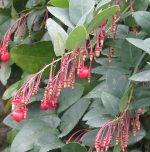 Coral plant is an evergreen vine found native to forest ravines in Chile. It is now an endangered species due to forest clearance for timber production but is available in nurseries. A member of the small family Berberidopsidaceae, the vine grows by twinning and can reach 20′ long. The dark green leathery leaves are heart-shaped and have spines on the margins. The pendulous coral flowers are produced in summer and autumn on long pink stems growing from the upper leaf joints. They are berry-like at first but star shape when open. Plants are effective growing on a trellis or over an evergreen tree or shrub. The genus name, Berberidopsis, comes from the Latin name for barberry, and the Greek word opsis meaning similar to. The specific epithet, corallina, is the Latin word meaning coral red and refers to color of the berries.
Coral plant is an evergreen vine found native to forest ravines in Chile. It is now an endangered species due to forest clearance for timber production but is available in nurseries. A member of the small family Berberidopsidaceae, the vine grows by twinning and can reach 20′ long. The dark green leathery leaves are heart-shaped and have spines on the margins. The pendulous coral flowers are produced in summer and autumn on long pink stems growing from the upper leaf joints. They are berry-like at first but star shape when open. Plants are effective growing on a trellis or over an evergreen tree or shrub. The genus name, Berberidopsis, comes from the Latin name for barberry, and the Greek word opsis meaning similar to. The specific epithet, corallina, is the Latin word meaning coral red and refers to color of the berries.
Type: Perennial evergreen vine
Bloom: Clusters of pendulous coral flowers are produced on long pink stems in summer and autumn.
Size: 20’ H
Light: Part shade to shade
Soil: Fertile, evenly moist, well-drained, acid to neutral
Hardiness: Zones 8-9
Care: Tie in new shoot as needed; apply slow release fertilizer and prune in spring; mulch in autumn to protect roots from the cold.
Pests and Diseases: Aphids
Propagation: Semi-ripe cuttings in mid summer to autumn; layering in early spring, seed in spring
Companion plants: Evergreen shrubs and trees
Photo Credit: Wikipedia
